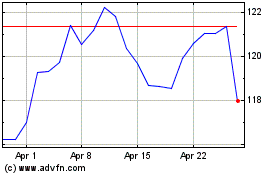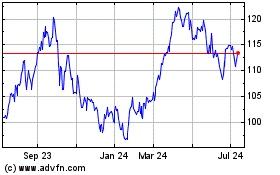By Sarah Kent, Bradley Olson and Georgi Kantchev
A new era of low crude prices and stricter regulations on
climate change is pushing energy companies and resource-rich
governments to confront the possibility that some fossil-fuel
resources are likely to be left in the ground.
In a signal that the threat is growing more serious, Exxon Mobil
Corp. is expected in the coming week to disclose that as much as
3.6 billion barrels of oil that it planned to produce in Canada in
the next few decades is no longer profitable to extract.
The acknowledgment by Exxon, after the company spent about $20
billion to put the oil sands at the center of its growth plans,
highlights how dramatically expectations have changed about the
future prospects of the region.
Once considered a safe bet, Canada's vast deposits are emerging
as among the first and most visible reserves at risk of being
stranded by a combination of high costs, low prices and tough new
environmental rules.
"For a lot of reasons the oil sands look like a prime candidate
for eventual abandonment," said Jim Krane, an energy fellow at Rice
University's Baker Institute. "One problem is that costs are
persistently higher. The high carbon content only makes it
worse."
During most of the past decade, Exxon and other giant oil
companies spent billions of dollars in Canada as part of a global
quest for new sources of supply, as analysts cautioned about "peak
oil," or the risk of running out of the resource. Prices surged to
$140 a barrel.
Companies were driven in part by the need to replenish their
reserves of oil and gas, since investors have traditionally looked
at such numbers as an important barometer for a resource company's
future.
But now, the worry is more about "peak demand." Amid a glut of
supply that led to a price collapse in 2014 and a tepid recovery,
investors and executives at some of the world's biggest energy
producers are considering the possibility that oil demand could
peak and then slow in the coming decades.
The shift from a preoccupation with insufficient supply to
worries about demand has altered investment priorities away from
high-cost opportunities in the Arctic, ultra-deep waters and the
oil sands.
Such projects can require billions of dollars in upfront
investment and seven to 10 years, or more, to bring returns.
Instead, companies are increasingly focusing on new sources of
crude oil, such as shale, that don't require the same massive
investment and that can get from development to production much
more quickly.
"Barring some geopolitical catastrophe that really changes the
outlook...all these other projects are going to take the wind out
of the oil sands," said Amy Myers Jaffe, executive director for
Energy and Sustainability at University of California, Davis.
Canada was once thought to hold the world's third-largest trove
of crude, enough to meet U.S. demand for almost 30 years, largely
due to the oil sands in northern Alberta -- giant deposits of crude
with the consistency of a hockey puck.
Today, only about 20% of those reserves, or about 36.5 billion
barrels, are capable of being profitable, according to energy
consultancy Wood Mackenzie.
In the decade leading up to the 2014 price collapse, companies
spent as much as $200 billion building megaprojects to extract
heavy oil in Alberta's boreal forest.
Canada, despite its high costs, was attractive to companies like
Exxon for its stability and proximity to the U.S.
To build its Kearl oil sands project in Alberta, Exxon invested
more than $20 billion, designing a less carbon-intensive process by
which the oil could be extracted without use of a high-emitting
plant called an upgrader.
The project was supposed to unlock 4.6 billion barrels of crude
over 40 years. First production came online in 2013 and was
expanded significantly two years later. The plant produced an
average of about 169,000 barrels a day last year, according to an
Exxon subsidiary.
The plant now produces approximately 300,000 barrels a day,
according to Exxon.
The lost reserves are a casualty of the price collapse that has
led more than 17 oil sands projects, representing about 2.5 million
barrels a day of production, to be canceled or delayed, according
to ARC Financial Corp.
Global companies such as Statoil ASA and Royal Dutch Shell PLC
that raced to build massive industrial projects in Canada have been
forced to write down the value of oil sands investments. Since
2012, the write-downs from those companies and Canadian producers
have exceed $20 billion.
Exxon is expected to drastically reduce its oil sands reserve
tally, but has stopped short of taking any financial write-down on
its Canadian assets. The company has said it continues to expect
that the reserves will be developed. Exxon also doesn't foresee an
oil demand peak in its forecasts through 2040.
"Even though we make that transfer, there is no change to our
operations or how we manage the business, those assets going
forward," Jeff Woodbury, Exxon's vice president of investor
relations, told investors last month.
U.S. Securities and Exchange Commission rules require companies
to evaluate their future prospects based on the average oil price
in the previous year -- about $43 a barrel in the U.S. for 2016.
Exxon has said it may take as much as 3.6 billion barrels off its
books because they lose money at low prices. The reserves may be
added again if prices rise, costs fall or operations become more
efficient, Exxon has said.
Exxon isn't the only company taking steps that underscore the
new realities and threats to future oil reserves. In its annual
energy outlook published earlier this year, BP warned that an
abundance of already-discovered oil resources and a slowdown in the
pace of demand growth will likely mean some barrels are never
recovered.
Exxon, along with Chevron Corp., is pouring billions into
expanding their footprint in shale oil, turning to projects that
can ramp up quickly to fill the void left by a lack of larger,
costlier developments.
Many of Canada's biggest producers are planning to spend less or
keep expenditures roughly flat this year compared with 2016, even
as spending in parts of the U.S. is starting to rise.
According to the Canadian Association of Petroleum Producers,
capital investment in the oil sands tumbled around 30% in both 2015
and 2016 and is expected to slide another 11% this year.
To be sure, oil output isn't expected to fall in Canada as it
has in the U.S., and some projects for which money has already been
spent may go forward, a sign of the resilience of oil sands
investments once money has been spent. That is because the cash
cost of producing barrels once projects are up and running is
low.
In addition to the oil sands' high costs, extracting and
refining the region's heavy oil or bitumen is on average a more
carbon-intensive process than almost any other type of extraction.
The Alberta and Canadian governments have introduced new rules,
including a cap on emissions and a carbon tax.
Write to Sarah Kent at sarah.kent@wsj.com, Bradley Olson at
Bradley.Olson@wsj.com and Georgi Kantchev at
georgi.kantchev@wsj.com
(END) Dow Jones Newswires
February 17, 2017 05:44 ET (10:44 GMT)
Copyright (c) 2017 Dow Jones & Company, Inc.
Exxon Mobil (NYSE:XOM)
Historical Stock Chart
From Aug 2024 to Sep 2024

Exxon Mobil (NYSE:XOM)
Historical Stock Chart
From Sep 2023 to Sep 2024
